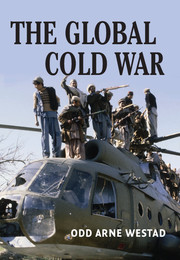Book contents
- Frontmatter
- Contents
- List of illustrations
- List of maps
- Acknowledgments
- List of abbreviations
- Introduction
- 1 The empire of liberty: American ideology and foreign interventions
- 2 The empire of justice: Soviet ideology and foreign interventions
- 3 The revolutionaries: anticolonial politics and transformations
- 4 Creating the Third World: the United States confronts revolution
- 5 The Cuban and Vietnamese challenges
- 6 The crisis of decolonization: Southern Africa
- 7 The prospects of socialism: Ethiopia and the Horn
- 8 The Islamist defiance: Iran and Afghanistan
- 9 The 1980s: the Reagan offensive
- 10 The Gorbachev withdrawal and the end of the Cold War
- Conclusion: Revolutions, interventions, and great power collapse
- Notes
- Index
8 - The Islamist defiance: Iran and Afghanistan
Published online by Cambridge University Press: 05 December 2012
- Frontmatter
- Contents
- List of illustrations
- List of maps
- Acknowledgments
- List of abbreviations
- Introduction
- 1 The empire of liberty: American ideology and foreign interventions
- 2 The empire of justice: Soviet ideology and foreign interventions
- 3 The revolutionaries: anticolonial politics and transformations
- 4 Creating the Third World: the United States confronts revolution
- 5 The Cuban and Vietnamese challenges
- 6 The crisis of decolonization: Southern Africa
- 7 The prospects of socialism: Ethiopia and the Horn
- 8 The Islamist defiance: Iran and Afghanistan
- 9 The 1980s: the Reagan offensive
- 10 The Gorbachev withdrawal and the end of the Cold War
- Conclusion: Revolutions, interventions, and great power collapse
- Notes
- Index
Summary
While the 1970s marked the high point of Cold War confrontation in the Third World, it was also the decade in which the hegemonic presumptions of US and Soviet ideologies began to be challenged. The Iranian revolution of 1978–79 broke with the pattern that revolutionary insurgencies against the established order came mainly from the Marxist inspired Left – on the contrary, after the overthrow of the shah, the Left was soon pushed aside by revolutionaries who found their inspiration in the Holy Koran, the Prophet, and, ultimately, in God. By the 1980s many of the social groups in the Islamic world from which left-wing parties had recruited in the past – especially students and intellectuals – had begun to provide cadres for political Islamic, or Islamist, parties and movements. At the same time, many of these parties also recruited from among those who had supported a Westernized form of development in the past, but who no longer felt that the meager economic results could weigh up the loss of cultural autonomy that such development implied.
Islamism as a political ideology has its origins in the resistance to colonial domination in the Middle East at the beginning of the twentieth century. Searching for a modern, often pan-Islamic state that would base its ideas and structures on the teachings of the Holy Prophet, the early Islamist leaders envisaged something akin to the European Reformation of the sixteenth century: a return to the original promise of their religion and the incorporation of religious laws into the foundation of the state.
- Type
- Chapter
- Information
- The Global Cold WarThird World Interventions and the Making of Our Times, pp. 288 - 330Publisher: Cambridge University PressPrint publication year: 2005

